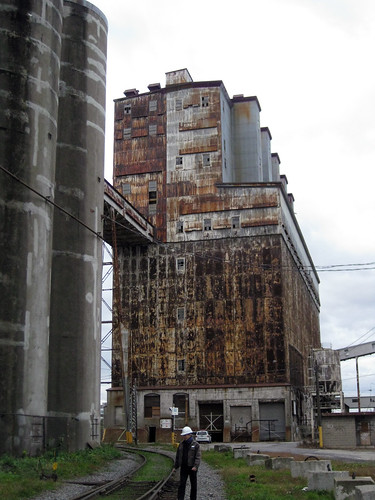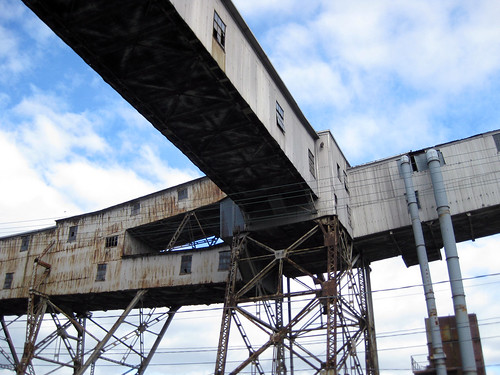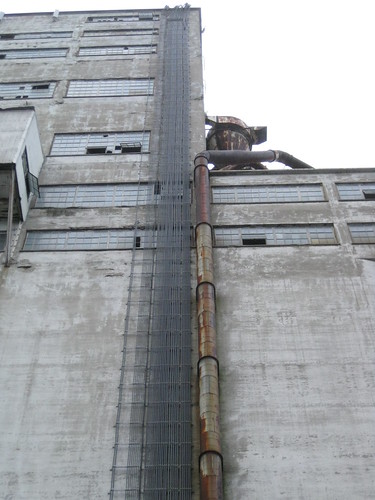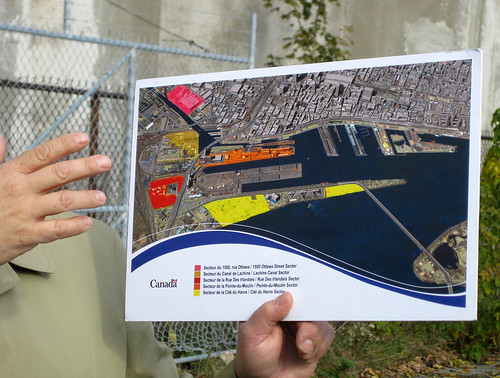I had tried once before to wander around the backside of Silo No. 5 but was I was quickly herded out by security guards. So I jumped at the opportunity to take Héritage Montréal’s legitimate tour of Silo No. 5, the imposing, if somewhat crumbly-looking grain elevator that stretches across the western end of the Old Port.
The occasion for the visit was that Silo No. 5 is about to change hands: the Montreal Port Authority will be selling it – and all of Pointe-du-Moulin – to the Canada Lands Company in November. The CSC is a non-profit organisation who none-the-less must pay market value for the lands they develop and make ends meet.
Although Silo no. 5 does not have any official heritage designation, the new owners seem eager to recognize the historical value of the site. Cameron Charlebois, a CSC representative, accompanied the tour and shared some thoughts on the future of the site (see the last section of this post).
Not-so-solid ground
Pointe-du-Moulin, the pier on which Silo No. 5 and the Farine Five Roses building stand is, 800 x 90 m construction made of dirt-filled wooden tubes. It was built in the 1840s with the excavated dirt from the widening of the Lachine Canal. The tubes are lashed together with steel cables to prevent the whole structure from floating apart.
In terms of redevelopment, Charlebois pointed out, this creates a certain “problématique de sous-sols“. The silos themselves are independent from the pier, with foundations in the ground below. I guess it’s no surprise that this pier hasn’t been snatched up by developer with more commercial interests.
Beautiful beast
Héritage Montréal’s Olivier Lapierre described how grain elevators were once a symbol of progress and pride: at the Paris Expo in 1900, Canada’s pavilion was in the shape of a grain silo. In his 1923 book, LeCorbusier described Montreal’s silos as the “splendid fruits of a new era.”
Silo No. 5 can store 30 olympic pools worth of wheat. Behind the structure, a tangle of elevators and conveyor belts were used to unload grain from trains and load it into ships.
But by the ’70s, Montreal’s port was more focused on shipping containers and today only 10% of the ships that come through the Port transport grain (Silo no.4 in Hochelaga remains active to handle this trade). Lapierre said this shift occurred because the Saint-Lawrence seaway had made interior ports closer to grain production more accessible and government policy favoured exporting grain westward out of Vancouver.
Silo No 5 was abandoned in 1995 and these days it serves as a 21-story pedestal for Bell antennas, and a custom echo-production site.
Image: Wires run up to a Bell Canada antenna perched on the roof of the silo.
I was surprised that even the central metal building is just a collection of 102 rectangular grain silos : erected in 1906, it was a pilot project to build silos out of steel, an upgrade from the wood. By the time the complex was enlarged in 1913, advances in technology made concrete the prime silo-building material.
Our guide said that some residents of the old port had asked for the structure to be town down: presumably they wanted an unimpeded view of the active industrial loading dock just behind.
What’s next: reuse and accessibility
Charlebois is skeptical that the redevelopment of this site would include housing. He points out that Pointe-du-Moulin is bisected by an active railway owned by the Port Authority, while on the adjacent pier, ships are still loaded and unloaded throughout the night. ADM, the company who owns the Farine Five Roses building, isn’t going anywhere.
Instead, Charlebois mentioned that vocations such as tourism, festivals, museums, and traditional urban development (by which I assume he means industrial given the zoning) would be considered. He cited the Evergreen Brick Works in Toronto as a good example of successful redevelopment of an industrial site.
“La conservation passe par l’usage” chimed in Lapierre.
But the silos may prove much harder to preserve than the old brick works: the structure has almost no interior space as nearly all of its volume consists of the silos. It seems likely that at least part of the structure will be demolished unless we can think of a use for 206 windowless concrete and steel tubes…Any takers?
A public dialogue will be held around February to discuss the future of the site. In the meantime, it seems like Canada Lands is eager to open the site up to the public: “on va tout faire pour que ce soit accessible au public l’été prochain,” Charlebois said.
He mentioned the idea of an activity on the pier during the Montréal en Lumières festival this winter and said he hopes to be able to open access to the top floors of the structure in the future so that we can all experience the “breathtaking, 360-degree panorama of the city and the river” which can be seen from the silo-tops.
Federally-owned sites around Montreal’s Old Port that may eventually be developed by Canada Lands Company (the pink square is the Bassins du nouveau havre project.)
Pointe-du-Moulin is just one of the properties around Montreal’s old port that will eventually be redeveloped by Canada Lands. I was impressed with their plans for the “Bassins du nouveau havre” site, released last year, which creatively highlighted the site’s history and incorporated environmental considerations. We have yet to see whether they’ll walk the talk, but I’m optimistic that these guys will be open to ideas that will benefit Montreal, and not just their bottom line.





6 comments
This is one of your best posts ever.
I did the same tour, it’s short but really nice. The silo should really be preserved in some way (no condos!). Maybe one could use Industriepark Nord in Duisburg, Germany as an example. The former steel mill is lit up every night, and a park during the day while also a museum.
One could also draw inspiration from the Modern Tate in London.
The insides of the silo-columns could be connected with walkways, providing a tour through these cathedral-like cylinders. This could be some sort of modern art gallery (with the correct lighting and atmosphere) or exhibition space. One could also add a couple of steps up in the passages between the silos, so that you circle through the silos up until the top.
I know of similar high buildings in Europe being converted to climbing walls or bases for zip-line installations, especially during the festival season. But that requires insurances and will probably be too hard in N-America.
Howdy!
Thermal Storage. With minimal changes they could save about $4 million/year in energy. The condos already in the neighborhood should get together and buy the silo so that they could save themselves some serious coin.
my childhood dream was to run up and down the “corridors”!
I was part of the tour conducted by Jean-Yves Bourdages (Heritage Montreal).
I am definitively in favor of Architecturally recycling Silo #5, because through many pictures of Montreal seen around the world thos Silo are a symbol.
An example of what can be done can be seen with what was done in France with the REHABILITATION DU SILO D’ARENC. MARSEILLE.